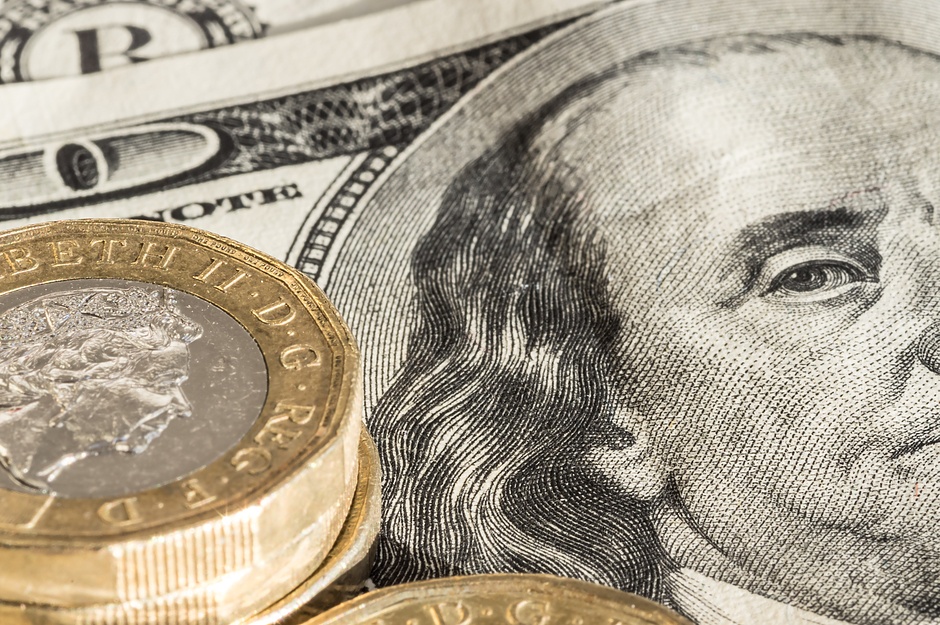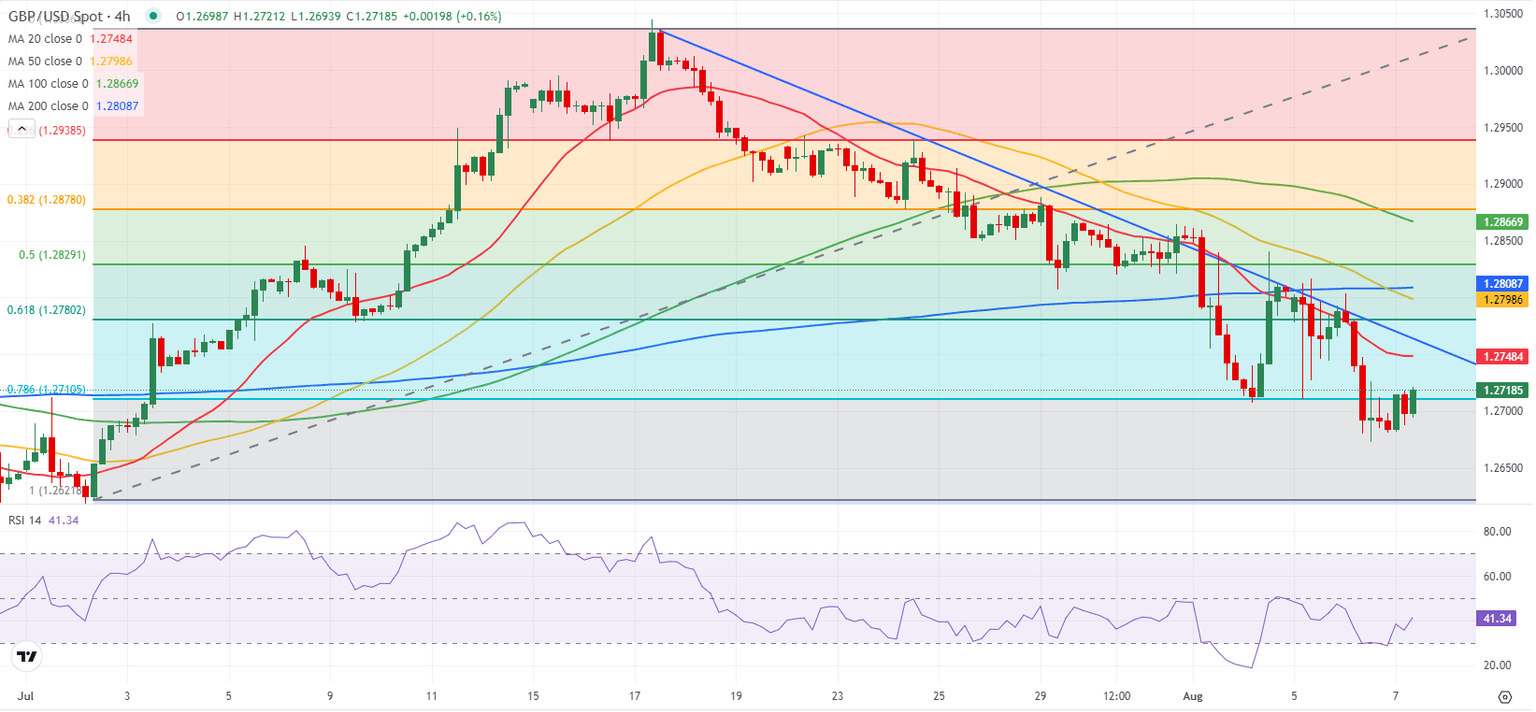GBP/USD Forecast: Pound Sterling stabilizes but short-term outlook remains bearish
- GBP/USD moves up and down in a tight channel near 1.2700.
- The near-term technical outlook suggests that the bearish bias remains intact.
- The US economic calendar will not feature any high-tier data releases on Wednesday.

GBP/USD lost nearly 0.7% on Tuesday and registered its lowest daily close since early July near 1.2670. The pair stages a correction and holds steady above 1.2700 in the European session on Wednesday.
British Pound PRICE This week
The table below shows the percentage change of British Pound (GBP) against listed major currencies this week. British Pound was the weakest against the New Zealand Dollar.
| USD | EUR | GBP | JPY | CAD | AUD | NZD | CHF | |
|---|---|---|---|---|---|---|---|---|
| USD | -0.07% | 0.66% | 0.43% | -0.94% | -0.92% | -1.16% | 0.52% | |
| EUR | 0.07% | 0.66% | 0.35% | -1.00% | -0.83% | -1.19% | 0.49% | |
| GBP | -0.66% | -0.66% | -0.24% | -1.62% | -1.49% | -1.84% | -0.17% | |
| JPY | -0.43% | -0.35% | 0.24% | -1.34% | -1.40% | -1.59% | 0.11% | |
| CAD | 0.94% | 1.00% | 1.62% | 1.34% | 0.07% | -0.22% | 1.30% | |
| AUD | 0.92% | 0.83% | 1.49% | 1.40% | -0.07% | -0.37% | 1.32% | |
| NZD | 1.16% | 1.19% | 1.84% | 1.59% | 0.22% | 0.37% | 1.70% | |
| CHF | -0.52% | -0.49% | 0.17% | -0.11% | -1.30% | -1.32% | -1.70% |
The heat map shows percentage changes of major currencies against each other. The base currency is picked from the left column, while the quote currency is picked from the top row. For example, if you pick the British Pound from the left column and move along the horizontal line to the US Dollar, the percentage change displayed in the box will represent GBP (base)/USD (quote).
The recovery seen in the US Treasury bond yields following Monday's sharp decline helps the US Dollar (USD) stay resilient against its rivals on Tuesday. Although the improving risk sentiment limited the USD's gains, GBP/USD failed to gather recovery momentum.
The market mood remains upbeat early Wednesday, allowing GPB/USD find a foothold. At the time of press, the UK's FTSE 100 Index was up nearly 1% on the day and US stock index futures were rising between 0.8% and 1.1%.
In the absence of high-tier data releases, another bout of risk rally after Wall Street's opening bell could support Pound Sterling. Later in the day, the US Treasury will hold a 10-year note auction. In case the high-yield arrives above 4%, the US T-bond yield continue to stretch higher and provide an additional boost to the USD, making it difficult for GBP/USD to stage a decisive rebound.
On Thursday, the US Department of Labor will release weekly Initial Jobless Claims data.
GBP/USD Technical Analysis
GBP/USD trades below the descending trend line and the Relative Strength Index (RSI) indicator on the 4-hour chart stays near 40 after testing 30 on Tuesday, suggesting that the bearish bias remains intact.
In case GBP/USD confirms 1.2710-1.2700 (Fibonacci 78.6% retracement of the latest uptrend, psychological level align) as resistance, 1.2620 (static level, beginning point of the uptrend) and 1.2600 (psychological level, static level) could be seen as next support levels.
On the upside, the descending trend line aligns as first resistance at 1.2750 before 1.2780 (Fibonacci 61.8% retracement) and 1.2800 (200-period Simple Moving Average).
Pound Sterling FAQs
The Pound Sterling (GBP) is the oldest currency in the world (886 AD) and the official currency of the United Kingdom. It is the fourth most traded unit for foreign exchange (FX) in the world, accounting for 12% of all transactions, averaging $630 billion a day, according to 2022 data. Its key trading pairs are GBP/USD, aka ‘Cable’, which accounts for 11% of FX, GBP/JPY, or the ‘Dragon’ as it is known by traders (3%), and EUR/GBP (2%). The Pound Sterling is issued by the Bank of England (BoE).
The single most important factor influencing the value of the Pound Sterling is monetary policy decided by the Bank of England. The BoE bases its decisions on whether it has achieved its primary goal of “price stability” – a steady inflation rate of around 2%. Its primary tool for achieving this is the adjustment of interest rates. When inflation is too high, the BoE will try to rein it in by raising interest rates, making it more expensive for people and businesses to access credit. This is generally positive for GBP, as higher interest rates make the UK a more attractive place for global investors to park their money. When inflation falls too low it is a sign economic growth is slowing. In this scenario, the BoE will consider lowering interest rates to cheapen credit so businesses will borrow more to invest in growth-generating projects.
Data releases gauge the health of the economy and can impact the value of the Pound Sterling. Indicators such as GDP, Manufacturing and Services PMIs, and employment can all influence the direction of the GBP. A strong economy is good for Sterling. Not only does it attract more foreign investment but it may encourage the BoE to put up interest rates, which will directly strengthen GBP. Otherwise, if economic data is weak, the Pound Sterling is likely to fall.
Another significant data release for the Pound Sterling is the Trade Balance. This indicator measures the difference between what a country earns from its exports and what it spends on imports over a given period. If a country produces highly sought-after exports, its currency will benefit purely from the extra demand created from foreign buyers seeking to purchase these goods. Therefore, a positive net Trade Balance strengthens a currency and vice versa for a negative balance.
Premium
You have reached your limit of 3 free articles for this month.
Start your subscription and get access to all our original articles.
Author

Eren Sengezer
FXStreet
As an economist at heart, Eren Sengezer specializes in the assessment of the short-term and long-term impacts of macroeconomic data, central bank policies and political developments on financial assets.


















